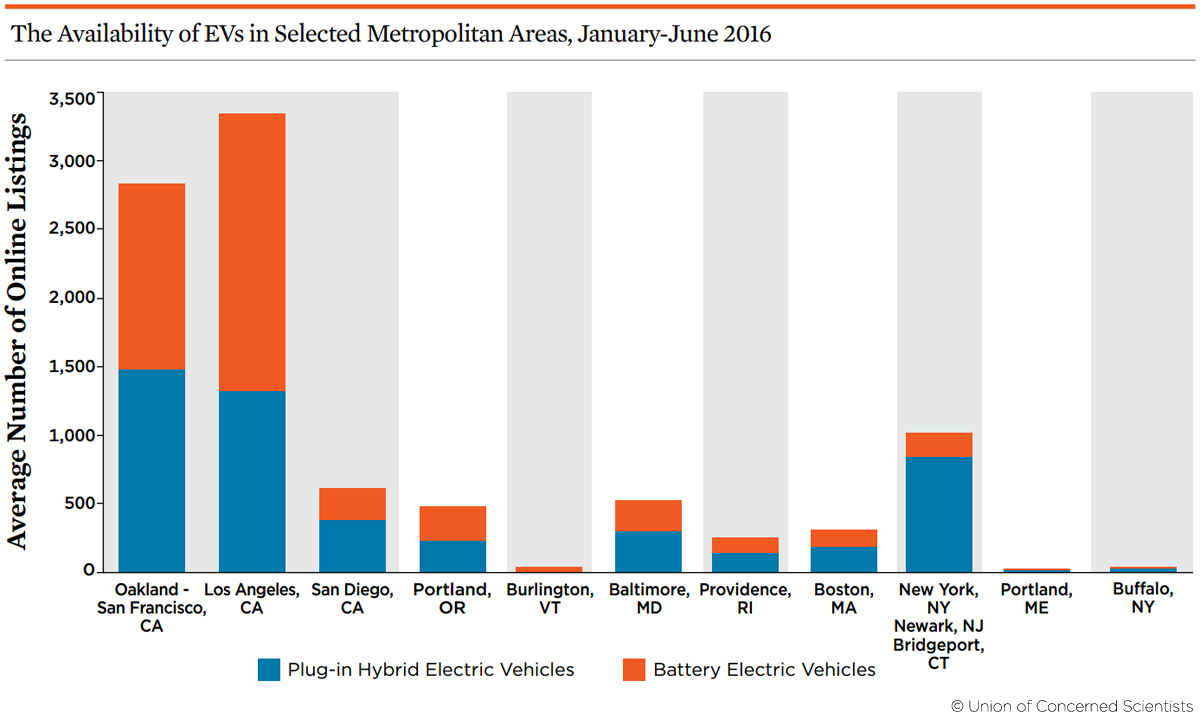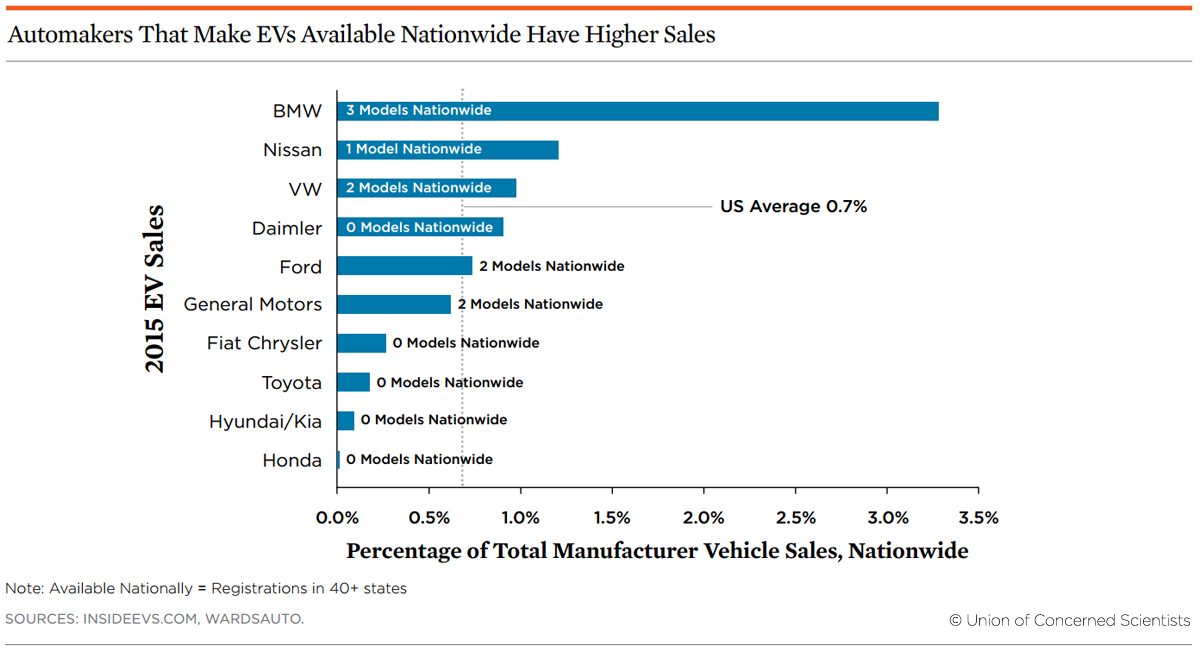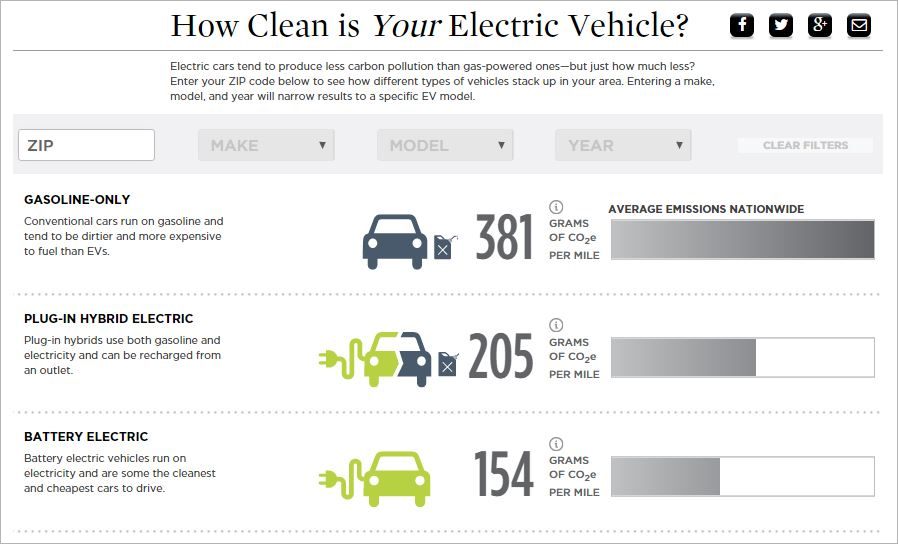Drivers love them. Consumers want them. The health of our climate depends on them.
Why, then, are electric vehicles (EVs) not as available as gasoline-powered cars and trucks? Recent UCS analysis found that most drivers, especially those outside California, would have a far harder time locating an EV than they would finding a similar gasoline model.
Our in-depth investigation of sales data and model availability found that leading automakers have profoundly different track records in bringing EVs to the US market. Some—including BMW, General Motors, Nissan, and Tesla—are leading efforts to make electric cars available. Others—notably Honda, Chrysler, and Toyota—are lagging behind.
Not in California? Good luck
Between 2010 and 2016, automakers introduced more than 24 electric models and sold over 400,000 new EVs in the United States. Most sales came from only three models—the Chevrolet Volt, the Nissan LEAF, and the Tesla Model S—and about half of the sales occurred in California.
Why California? The state’s “Zero Emission Vehicle” program requires automakers to sell EVs, which are also incentivized through rebates, a robust charging infrastructure, and access to carpool lanes. In response, automakers have made more models available for sale—and filled more dealers’ lots—than anywhere else in the country.

California drivers chose from 22 different EV models in 2015. No other state offered more than 14.
Outside California, the picture changes considerably. In 2015, Californians could choose from over 20 models; no other state had more than 14, and many offered virtually none.
The difference between metropolitan areas was even starker. For example, between January and June of 2016, Boston had 90 percent fewer EV listings than Oakland, when adjusted for relative car ownership.

The auto industry points to regional sales numbers to argue that non-Californian drivers aren’t interested in electric cars. But a 2016 survey, conducted by UCS and Consumers Union, found similar consumer interest in EVs between California and the Northeast.
The survey also found that 86 percent of drivers won’t buy cars that they can’t test drive. Our availability study suggests that finding and test-driving an EV may be difficult, even when drivers are interested.
Leaders and laggards
The country’s major automakers differ markedly in how they approach, market, and sell electric-powered vehicles. Tesla has made electric cars and SUVs central to their business strategy and sells only battery-electric vehicles. Others, including BMW, General Motors, and Nissan, have made earnest efforts to bring EVs to market, and appear to embrace an EV-dominated future.
But Honda, Toyota, Fiat Chrysler, and Hyundai are all lagging, offering very few models and limiting where they’re available for sale.

Automakers that offered more EV models—and made them available nationwide—sold a higher percentage of EVs overall.
The leaders
BMW is an EV industry leader. It leads all major automakers in electric sales as a proportion of total sales: more than 3 percent across the United States, and topping 7 percent in California.
General Motors, with the Chevrolet Volt, and Nissan, with the LEAF, were early leaders in developing and selling electric cars. The Volt is the United States’ top-selling plug-in hybrid EV, and the LEAF is the top-selling battery EV since 2010.
Tesla only sells electric-drive vehicles, building them “on-demand” and bypassing the traditional dealership model. It was the top-selling EV carmaker in 2015 and its upcoming Model 3 has attracted unprecedented interest.
The laggards
Honda currently offers no plug-in electric vehicles in the United States; even when the company did sell EVs, its efforts lagged behind those of other automakers. Honda’s total EV sales in the United States since 2011 are lower than General Motors’ EV sales in a single month (April 2016).
Toyota leads in hybrid vehicle technology, but lags in deploying plug-in electric vehicles. Despite successfully selling a plug-in version of the popular Toyota Prius, the company discontinued the model and currently doesn’t offer a plug-in EV for sale in the United States.
Fiat Chrysler successfully sells its only EV, the Fiat 500e, in California and Oregon, but doesn’t offer any electric option in the rest of the country.
Hyundai/Kia has not made its two plug-in models widely available, and its EV sales are significantly lower than those of most other major automakers.
Read more in the full report or executive summary.






